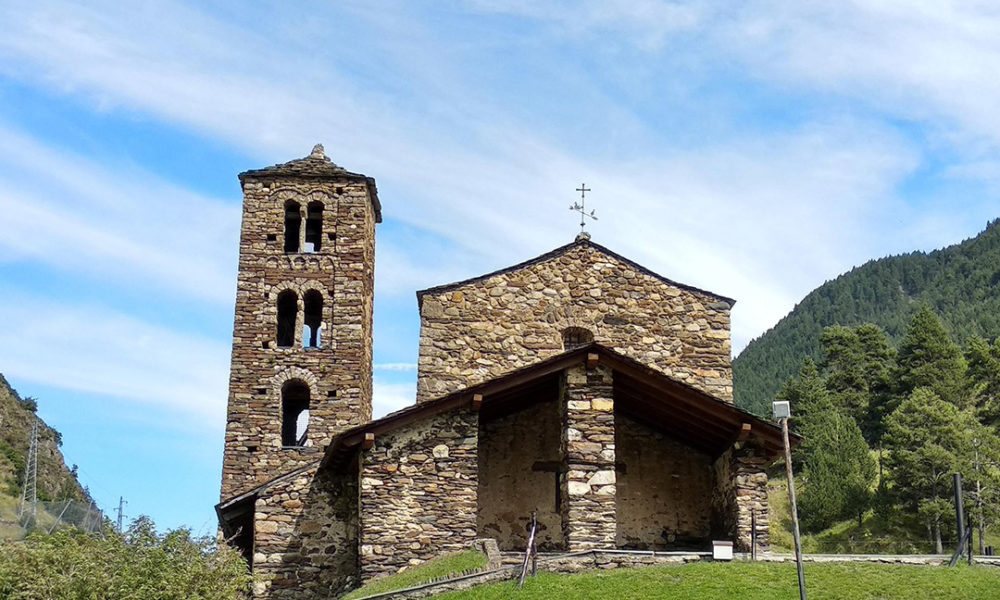This time we take you on a tour of Andorra’s Romanesque churches, which are open from July to September for guided visits. So that you can get to know the whole country, we leave you with 7 Romanesque churches, one located in each parish. Some of them are located in authentic viewpoints from where you can discover landscapes and curious places.
Sant Joan de Caselles
We begin with Canillo, the first parish in protocol order and also where Els Llacs Mountain Apartments are located.
At the entrance to the village of Canillo (going down from the flats) you will find this beautiful church dating from the 11th and 12th centuries. Entrance is free. The most surprising feature is the preservation of the two original porticoes built in the 16th and 17th centuries. Also of note are the Romanesque mural scenes and the altarpiece with Renaissance influences inside the church.
Note for walkers: near the church you can take the Camí del Gall, a nature trail that will take you to Soldeu.
Sant Romà de les Bons
We continue downhill to reach Encamp. Sant Romà de les Bons is actually a historical site that conserves the 12th century church of Sant Romà, a 4-storey defence tower, the remains of a 13th century civil building, 2 dovecotes and a water tank excavated in the rock. The Romanesque paintings in the church are a reproduction, as most of the originals are in the National Art Museum of Catalonia (MNAC) in Barcelona.
It is built at the top of the village and has an incredible view over the whole valley.
Ordino: Sant Martí de La Cordinada
We go into the northern valley of Andorra to visit La Cortinada, a village in the parish of Ordino. Over the centuries Sant Martí has undergone a number of modifications, including a change of orientation. Inside it conserves mural paintings, a high altar, a polychrome wooden altarpiece and altarpieces from the Baroque period.
The surrounding area is also worth a visit, as it is home to a millstone and a sawmill, as well as the Cal Pal house-museum, testimonies to the life of yesteryear.
La Massana: Sant Cristòfol d’Anyós
From Ordino we go down to La Massana to reach the village of Anyós. The Romanesque church of Sant Cristòfol is located in such a way that you can see the entrance to the parish through Escaldes and also the villages of La Massana and Sispony. It dates from the 12th century, but it has also undergone transformations. Inside there are 16th century paintings that coexist with other more modern ones, as the original ones were removed in the 1930s.
Andorra la Vella: Santa Coloma and Colomba space
We arrive in the capital of the country to visit one of the oldest churches of pre-Romanesque origin. It was built between the 8th and 9th centuries and its circular bell tower is very unusual in pre-Romanesque times.
Nowadays, inside the church there is a video mapping of the original mural paintings, a spectacle that is well worth the visit. It must be visited with the Columba space, where you can see part of the original frescoes that the government of Andorra was able to recover in 2007. A visit to the old quarter of Santa Coloma is highly recommended.
Sant Julià de Lòria: Canòlich
We are about to finish this route. We arrive at the sixth parish in order of protocol: Sant Julià de Lòria, where we will visit its famous sanctuary of Canòlich, to which pilgrims used to climb on foot (at 1635 metres) to show their devotion to their virgin. Nowadays, on the first Saturday in June, the inhabitants of Sant Julià still gather to celebrate their patron saint, and quite a few of them go up on foot.
The building dates from the 20th century, although it was built on the foundations of an old Romanesque church. Inside it preserves an 18th century Baroque altarpiece and ceramic murals.
The views from here are spectacular and if you continue climbing you will reach Os de Civis, a Spanish village with access only from Andorra.
Escaldes-Engordany: Sant Miquel d’Engolasters
This is the last stop on our tour of some of Andorra’s Romanesque churches. To do so, we will go up to Engolasters to enjoy Sant Miquel, from the 12th century, whose architectural construction still conserves many original elements. The painting of the semicircular apse is an exact copy of the original, which is kept in the MNAC in Barcelona. As a curiosity that you won’t find in the rest of Andorran churches, you will see that there are sculpted heads at the top of the bell tower.
After visiting the church, you can walk along the Camí de les Fonts, a well-signposted and easily accessible mountain path, or go up to Engolasters lake, also a very pleasant walk in the surrounding area.
You can do these visits on the same day or over several days.
If you choose the latter option, we recommend that you book at Els Llacs Mountain Apartments to recover your strength.





